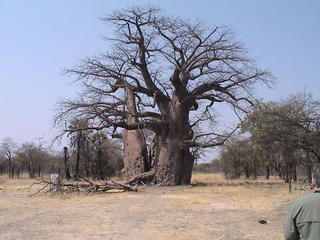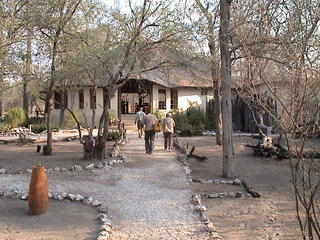We spoke to the hotel manager about Rundu and tourism in the area. He said that five years ago Angolan rebels had crossed the river and murdered five French tourists.
View of Angola, on the far side of the Okavango River from our hotel in Rundu, Namibia
The town was only now starting to return to the level of tourists seen then. Yet another victim of the troubles in so many parts of Africa.
We were able to leave Rundu at the very respectable time of 10:30am. Yet another day of arrow straight roads, but this time alongside the road were stalls selling local crafts - wood carvings, pots and strangely models of Landrovers and helicopters, both made out of wood. We stopped and bought a helicopter as a present for Stuart who had very generously paid for our stay in Rundu. This had been his thanks to us for joining him and Sheri on the three day excursion away from the tour. It had been his idea in the first place. Also it was an appropriate present as Stuart pilots his own helicopter. As we bought the gift, twenty children ran up to us. We decided to give them some biscuits and the lady in charge of the stall organised them to make sure they received one each. We then took photos of them all. Even though they have such a hard life they were all smiling and laughing. A moment to remember.
Our drive west to Etosha took us on our first Namibian gravel roads. These are renowned in the rally world for their smoothness. Apart from the noise of the tyres on the fine gravel, and the occasional pothole, you could be driving on tarmac. The one thing you never want to have happen is to be behind another vevicle, as the dust thrown up is unbelievable. To be clear of the dust, when there is no side wind to blow it away, you need to be about half a mile behind the vehicle in front of you. It makes it very difficult to overtake a slower car as you are completely blind as you get close. The smoothness of the gravel roads means you can travel at quite fast speeds, not much slower than on the tarmac.
A short detour off the gravel road took us to a local monument, a giant baobab tree. They are wonderful trees. This one was 30 metres in circumference, but apparently they can grow to 45 metres. They are amongst the longest living trees, living for more than 3,000 years.
We were able to leave Rundu at the very respectable time of 10:30am. Yet another day of arrow straight roads, but this time alongside the road were stalls selling local crafts - wood carvings, pots and strangely models of Landrovers and helicopters, both made out of wood. We stopped and bought a helicopter as a present for Stuart who had very generously paid for our stay in Rundu. This had been his thanks to us for joining him and Sheri on the three day excursion away from the tour. It had been his idea in the first place. Also it was an appropriate present as Stuart pilots his own helicopter. As we bought the gift, twenty children ran up to us. We decided to give them some biscuits and the lady in charge of the stall organised them to make sure they received one each. We then took photos of them all. Even though they have such a hard life they were all smiling and laughing. A moment to remember.
Our drive west to Etosha took us on our first Namibian gravel roads. These are renowned in the rally world for their smoothness. Apart from the noise of the tyres on the fine gravel, and the occasional pothole, you could be driving on tarmac. The one thing you never want to have happen is to be behind another vevicle, as the dust thrown up is unbelievable. To be clear of the dust, when there is no side wind to blow it away, you need to be about half a mile behind the vehicle in front of you. It makes it very difficult to overtake a slower car as you are completely blind as you get close. The smoothness of the gravel roads means you can travel at quite fast speeds, not much slower than on the tarmac.
A short detour off the gravel road took us to a local monument, a giant baobab tree. They are wonderful trees. This one was 30 metres in circumference, but apparently they can grow to 45 metres. They are amongst the longest living trees, living for more than 3,000 years.
Giant baobab tree
We arrived at our lodge on the edge of the park at about 2pm. At 3.30pm the first car to arrive from Maun was Jim Carr in his orange coloured Discovery. Shortly afterwards Jim Taylor turned up. The last to arrive, at 9pm, were Jingers and our tour doctor Greg Williams. They had not been able to leave Maun till 11am as several cars were delayed for mechanical reasons and as they are the 'sweeper' car they have to follow behind the tour to help anyone in trouble. The day was rounded off by a wonderful meal in the open where we exchanged our experiences of the last three days.
The Aoba Lodge on the edge of the Etosha National park
A couple of facts. Day time temperatures are aound 33-35 degrees celsius and we have now travelled just under 7,000 kms. I hope to post some more photos when we get back into South Africa on the 30th. If that is not possible I will be creating a gallery when we return to the UK. As they say 'watch this space'.



No comments:
Post a Comment